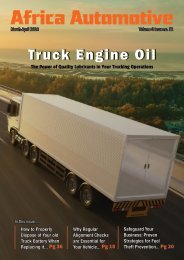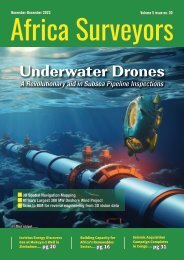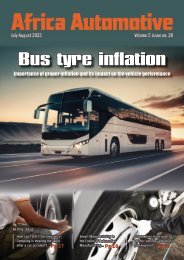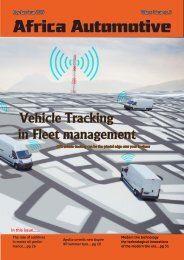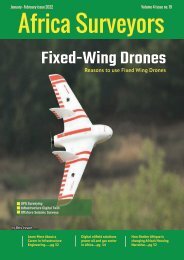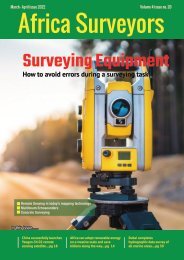Africa Automotive News September-October digital issue 2019
Africa Automotive prides itself to be the ONLY Africa’s leading and MOST authoritative magazine for the automotive industry in Africa with printed copies for the automotive industry decision makers in both government, NGO’s and private sector. The Bi-monthly magazine offers cost effective advertising services that get results and improves growth in the auto B2C and B2B sector, keeping an eye on latest technologies in Africa and across the world, the magazine predominately covers the developments in the Africa auto industry.
Africa Automotive prides itself to be the ONLY Africa’s leading and MOST authoritative magazine for the automotive industry in Africa with printed copies for the automotive industry decision makers in both government, NGO’s and private sector. The Bi-monthly magazine offers cost effective advertising services that get results and improves growth in the auto B2C and B2B sector, keeping an eye on latest technologies in Africa and across the world, the magazine predominately covers the developments in the Africa auto industry.
You also want an ePaper? Increase the reach of your titles
YUMPU automatically turns print PDFs into web optimized ePapers that Google loves.
Safety Tips<br />
Caught up in a sinking car?<br />
What to do<br />
More common occurrences include being swept off the<br />
road in a flash flood as a result of a natural disaster<br />
The need to escape from a sinking<br />
vehicle is a rarity. According to<br />
available data less than one-half of<br />
1% of all auto crashes involve submersion.<br />
Yet, it does happen, and we need to<br />
ask the question whether we would be<br />
able to survive such an experience?<br />
With enough know-how, survival is definitely<br />
possible and we need to equip motorists<br />
with information that will enable<br />
them to survive. Motorists seldom have<br />
to confront a bridge collapsing underneath<br />
them and the risks are more often<br />
associated with cars driving off quay-sides<br />
or into rivers. Also included are problems<br />
that arise when the parking brake isn’t<br />
applied properly with cars simply rolling<br />
down embankments into lakes or rivers.<br />
More common occurrences include being<br />
swept off the road in a flash flood as a<br />
result of a natural disaster. It is important<br />
to acknowledge that not all experts agree<br />
on all the survival tips and the precise<br />
sequence of escape – but there are some<br />
common threads that need to be identified<br />
and learnt from. On balance, it seems<br />
that the best course of action is to try<br />
and get out as soon as possible.<br />
What to expect from a sinking<br />
vehicle?<br />
• The speed at which a car will sink<br />
depends on several factors, including<br />
the distance of the fall, speed<br />
and angle of entry and the physical<br />
characteristics of the vehicle.<br />
• Most entries of vehicles into the<br />
water are smooth entries with the<br />
water cushioning the blow. Most<br />
people survive the initial impact with<br />
minimal or no injury at all.<br />
• If you remain relatively calm there<br />
should be enough time for you to<br />
take action to save your life and the<br />
lives of your passengers.<br />
• Newer cars that are better at keeping<br />
sound out will likely also be better at<br />
keeping water out.<br />
• Most vehicles will float for a minute<br />
or two before beginning to sink. Cars<br />
usually sink at an angle, with the<br />
weight of the engine pulling down<br />
the front first. A rear-engine car sinks<br />
trunk-first.<br />
• It is possible that the vehicle might<br />
flip onto its roof in deeper water.<br />
• In a test in a controlled environment<br />
experts from the police tried to sink<br />
a car and were surprised to find that<br />
it took 5 minutes for the vehicle to<br />
sink.<br />
• In a car that sinks front first, there<br />
will be a bubble of air in the back,<br />
but you should stay in the front …<br />
the front windows are often bigger<br />
and easier to get out of — for all<br />
passengers.<br />
•<br />
Vehicle sinking characteristics<br />
An upright floating vehicle may take<br />
2–4 min to completely submerge below<br />
the water surface, however occupants<br />
have only one minute (The Flotation<br />
Phase) during which escape is possible.<br />
During this period, water is rising against<br />
the doors, preventing them from being<br />
opened, however windows can still be<br />
opened and occupants can exit through<br />
them. After the first minute or so, the water<br />
rises up against the windows exerting<br />
enough pressure to prevent them from<br />
being opened as well (Sinking Phase).<br />
From this point on, although there is still<br />
air in the passenger compartment, none<br />
of the doors or windows can be opened<br />
and the occupants are confined to death<br />
through drowning.<br />
Cars and pickup trucks are inherently<br />
stable in the upright position because of<br />
the mass and low position, of the motor.<br />
Therefore, if passenger vehicles land in<br />
the water upside down, and the windows<br />
are closed and remain intact, the vehicles<br />
will eventually right themselves by rolling<br />
in the x axis. Likewise, vehicles landing<br />
in water at a steep pitch (angled in the y<br />
axis) will also eventually settle in the upright<br />
position. Even at a steep pitch of up<br />
to 60° or more, from horizontal, a vehicle<br />
will penetrate the water and then bob<br />
back up in the upright position and enter<br />
the Flotation Phase. All of these factors<br />
need to be considered in the design of<br />
an AWOS.<br />
Field tests<br />
Prototype systems were installed on<br />
two used cars at a gravel pit lake near<br />
Winnipeg, Canada. All fluids were drained<br />
from the vehicles and a crane was used<br />
to place the vehicles in the lake either<br />
by lowering them straight down into the<br />
water (static tests) or by swinging the<br />
vehicle into the water to produce forward<br />
movement (dynamic tests).<br />
Upright immersions: In both static<br />
and dynamic tests, the windows opened<br />
immediately and effectively when the vehicles<br />
landed upright in the water. In each<br />
case the windows were open before water<br />
rose to the level of the windows and this<br />
would have provided time for occupants<br />
to exit before water flowed into the passenger<br />
compartment.<br />
Inverted immersions: One test vehicle<br />
was statically lowered into the water in an<br />
inverted position. The windows opened<br />
quickly and the vehicle sank quickly while<br />
remaining in the inverted position. In this<br />
scenario, escape would have been unlikely<br />
due to a combination of the short time<br />
available and being in a disorientating<br />
inverted position.<br />
Basic Survival Tips<br />
44 <strong>Africa</strong> <strong>Automotive</strong> <strong>News</strong> l <strong>2019</strong> <strong>September</strong>-<strong>October</strong> <strong>issue</strong> l <strong>2019</strong>




